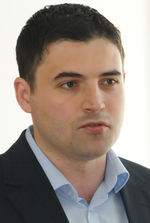Socijaldemokratska partija Hrvatske
| Socijaldemokratska partija Hrvatske | |
|---|---|

|
|

|
|
| Party leader | Before that, Bernardić |
| Deputy Chairman |
Peđa Grbin Zlatko Komadina Boris Lalovac Ranko Ostojić |
| Headquarters | Trg Drage Iblera 9 10000 Zagreb |
| Youth organization | Forum mladih SDP-a |
| Alignment | Social democracy |
| Colours) | red |
| Parliament seats |
37/151 |
| Number of members | 36,987 |
| International connections | Progressive Alliance (full member), Socialist International (full member) |
| MEPs |
4/12 |
| European party | European Social Democratic Party |
| EP Group | S&D |
| Website | http://www.sdp.hr |
The Social Democratic Party of Croatia (Croatian Socijaldemokratska partija Hrvatske , SDP ) is a social democratic party in Croatia .
The SDP emerged from the former Communist Party of Croatia (SKH). In the first free elections in the spring of 1990, she stood with two strong wings as the SKH-SDP and won almost 22 percent of the vote. The communist wing under Stanko Stojčević was in favor of slow economic reforms with the goal of reformed socialism. The progressive wing with Ivica Račan advocated political pluralism in a sovereign Croatia.
The reform wing prevailed after the 1990 elections and at the party congress on November 3, 1990, the party was renamed Stranka demokratskih promjena (SDP, Party of Democratic Changes). The SDP turned into a Croatian social democratic party. Many communist members and a large part of the MPs left the party. The SDP lost under the leadership trio Ivica Račan, Zdravko Tomac and Dušan Bilandžić in importance.
The SDP mainly addressed urban voters and mostly held back criticizing the policy of the HDZ . In August 1992 the party won eleven seats in the parliamentary elections, eight of which were from the Serb minority votes.
In April 1993 the party was renamed Socijaldemokratska Partija Hrvatske .
In the 1995 elections, the party received 8.9% of the vote, equivalent to 10 seats, which was a surprisingly good result.
In the summer of 1999, the SDP and the social-liberal HSLS formed an opposition center-left coalition and won the parliamentary elections on January 3, 2000 with 45% of the vote. Together with an opposition alliance made up of six smaller parties, the opposition gained a comfortable majority in parliament. The HDZ, which had been in power for ten years, was thus replaced. The SDP chairman Ivica Račan became prime minister. The presidential candidate of the alliance of SDP and HSLS, the HSLS boss Dražen Budiša , could not achieve a majority of votes with 44% in the runoff election on February 7, 2000 against Stipe Mesić . After the parliamentary elections in 2003, the government majority was lost and the SDP became the main opposition party in Croatia.
In the parliamentary elections in 2007, the SDP had gained many votes. But since the HSLS opted for a government coalition with the HDZ, the SDP remained in the opposition.
Since June 2, 2007 Zoran Milanović was party chairman. On November 26, 2016, Davor Bernardić was elected as his successor.
At the end of 2010 the Kukuriku coalition was founded with the aim of running in the parliamentary elections on December 4, 2011 together with HNS , IDS and HSU .
On December 4, 2011, under the leadership of the SDP , Kukuriku became the parliamentary group with the largest number of votes and held the government until the 2015 election. Since then she has been in the opposition.
literature
- Arno Weckbecker and Frank Hoffmeister, The Development of Political Parties in Former Yugoslavia , 1997 ( ISBN 3-486-56336-X ), p. 183ff
Individual evidence
- ↑ net.hr Sanader sastavlja Vladu (Croatian)
- ↑ Croatian opposition gets new boss , Tiroler Tageszeitung online, November 27, 2016
- ↑ salzburg.com: Government formation in Croatia before completion ( page no longer available , search in web archives ) Info: The link was automatically marked as defective. Please check the link according to the instructions and then remove this notice. (January 5, 2012)
- ↑ derStandard.at: Buendnis Kukuriku wins parliamentary elections (January 5, 2012)